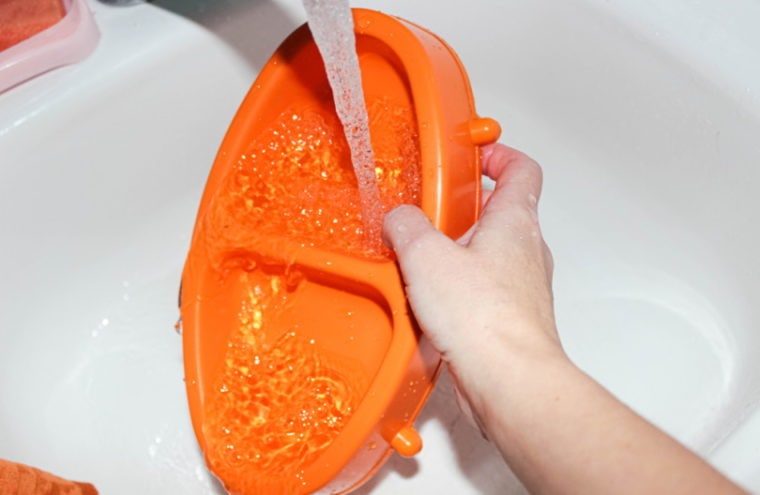
As a pet owner, keeping your cat’s personal items clean is a top priority. Their bedding, litter box, and even their food bowls should be kept nice and clean to keep your cat happy, and most of all, healthy. When it comes to their food bowls, however, taking steps to clean them properly is a must. This helps avoid sanitary issues around your home and cross-contamination with your family’s food utensils, while also ensuring that your cat’s bowls are up to par for them to eat out of.
In this step-by-step guide, we will take you through the proper techniques for cleaning your cat’s food bowls. Whether you’ve your cat on a normal diet or a raw food diet, you will be able to use this cleaning method to rest easier knowing your kitty’s bowls are clean and their food is safe.
Is Using a Dishwasher Safe for My Cat’s Bowls?
Before we go through the steps of hand-washing your cat’s food bowls, let’s first answer the question of whether using your dishwasher is safe. The answer to this question is, yes, it’s safe, but is it practical?
Before placing your cat’s bowls in the dishwasher, you need to hand-wash them first. This removes any food bits that may be stuck on, which we all know, dishwashers aren’t the best at removing. You would also need to run the dishes alone. You wouldn’t want to place your cat’s bowls in the same sink water as your family’s food utensils and the same rule applies here. If you don’t mind running your dishwasher for a cycle with only your cat’s bowls inside then, by all means, use your dishwasher and make life easier. However, please do consider the electricity and water used for one bowl, which means this is not the most environmentally friendly option.
If you aren’t a fan of running your dishwasher with only a few items inside, then the following steps will walk you through how to properly hand-wash your cat’s dishes and keep them free of bacteria and other unsightly extras that may be crawling around inside them.
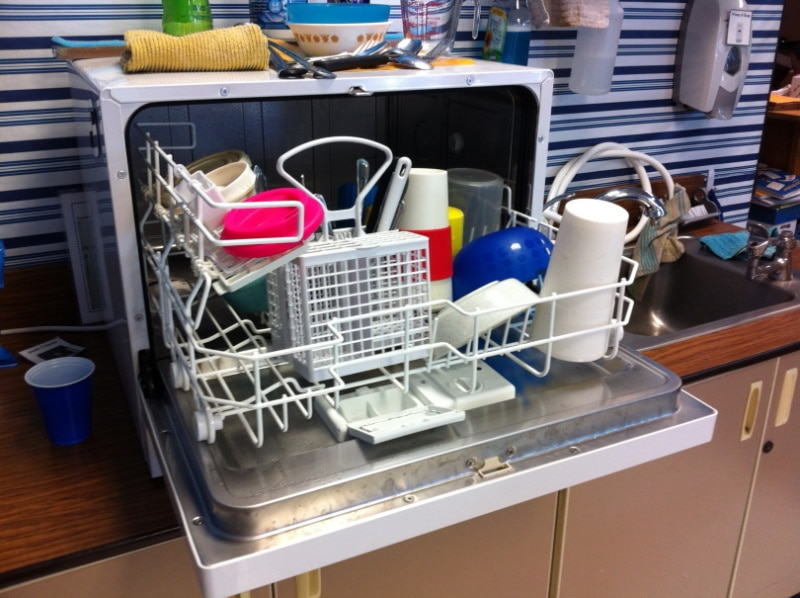
Before You Begin
Like with any project you take on, there are things you need to do before you begin washing your pet’s food bowls. The first thing you should do is grab a pair of gloves. Gloves will help you avoid getting any bacteria on your hands. Then empty the bowls thoroughly. This is the best way to avoid dealing with bits of food. You’ll also need dish liquid, a non-abrasive sponge or dishcloth, and a dry towel.
The 7 Simple Steps to Clean Your Cat’s Bowl
1. Wash Your Dishes First
As we’ve already mentioned, you shouldn’t wash your family’s dishes alongside your cat’s bowls. To avoid this issue, wash up your dishes first. This ensures no issues with cross-contamination from your cat’s food or any bacteria that may be inside the bowl.
2. Use Hot Water and Dish Soap
If your dishwater is still hot and soapy after you’ve finished your dishes, you can use it for your cat’s bowls. If not, it would be best to run more. The hot water and dish soap are needed to get the bacteria and grime off your cat’s bowls.
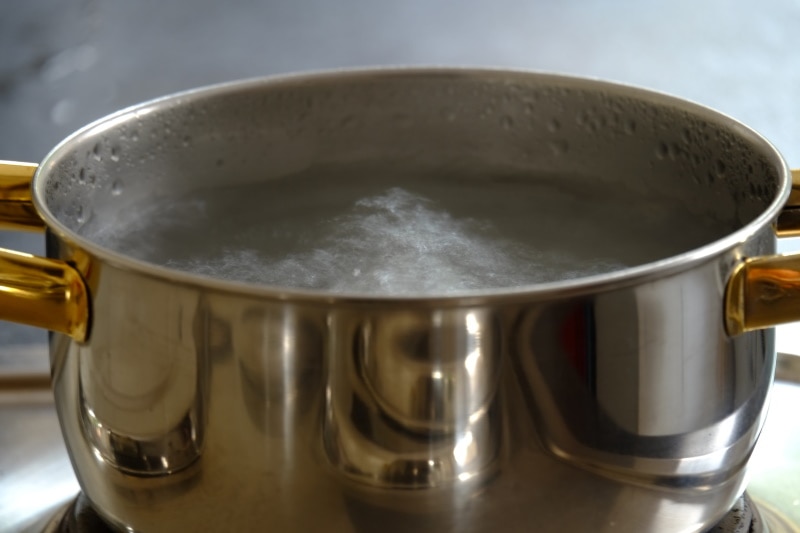
3. Soak If Needed
For cat bowls that haven’t been cleaned recently or those that may have quite a bit of stuck-on food left behind, soaking may be necessary. Make sure the bowls are completely submerged. You can leave them in hot, soapy water for 30 minutes to make washing easier.
4. Use Your Dishcloth or Sponge
Keep in mind, when cleaning your cat’s bowls, that abrasive sponges can damage the bowls. This is why it’s best to use a non-abrasive sponge or dishcloth. Your cleaning cloth or sponge shouldn’t be the same one you use for your family’s dishes and utensils. Keep a sponge specifically for your cat. Once you have your chosen item, simply wash your bowls like normal and remove any bits of food or grime that may be left.
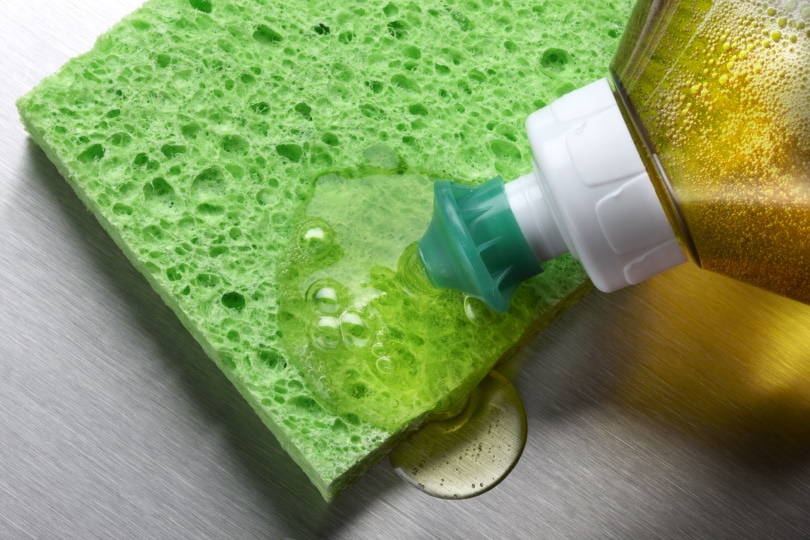
5. Rinse
This is a very important step. It’s important to rinse the food dishes thoroughly so your cat isn’t exposed to the dish soap. While the dish liquid won’t hurt your cat, it could make them avoid their food bowl if they smell it, leave a soapy residue and taste to their food, and possibly upset their stomach if there’s a lot left.
6. Allow to Dry
If you have time, you can leave your thoroughly washed and rinsed cat bowls to air dry. For those who have a cat waiting for more food and water, it’s time to use your dry towel. A dry bowl is best, especially for your cat’s food. No cat wants to eat soggy kibble or wet food that has additional water included.
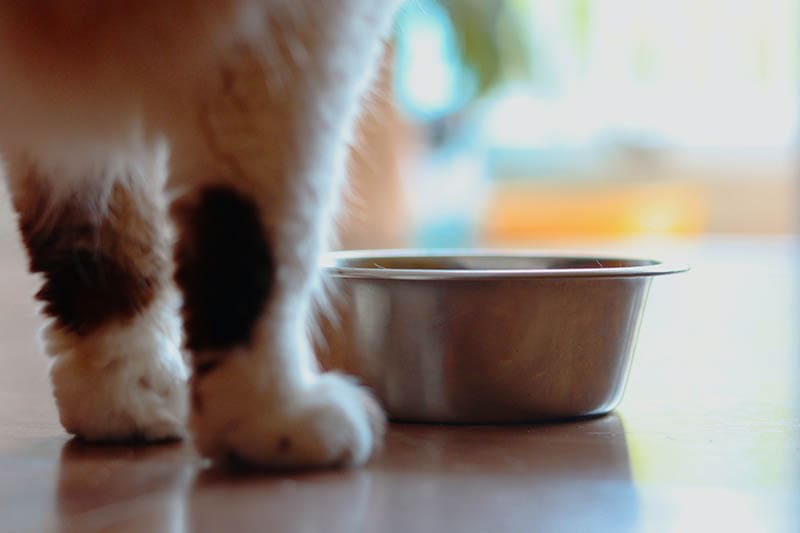
7. Clean and Finish Up
Now that your cat’s bowls are clean, all that’s left is to clean up your work area. Let the dishwater out, scrub out your sink, and put away your sponge or dishcloth. Remember, if you use a sponge, keep it separate from your family’s dish sponge. If you chose a dishcloth, wash it in your washing machine to ensure it’s safe to use next time.
Should I Disinfect My Cat’s Bowls?
Disinfecting your cat’s bowls isn’t necessary if you wash them routinely. However, if you haven’t washed them lately and feel they need a bit more than regular washing, disinfecting is an option. To do this, use 1 part bleach with 10 parts water. Wear your gloves then add your cat’s bowls to the solution and allow them to soak for roughly 10 minutes. Once finished, simply rinse well and allow them to dry. Your kitty’s bowls will then be sanitized and ready to use again.
How Often Should I Wash My Cat’s Bowls?
With the busy lives we lead, it’s not unheard of for a pet’s bowls to go without a thorough washing every day. However, according to the FDA, they feel your pet’s bowls should be cleaned for each feeding they receive. The best way to keep your kitty safe from any illness that can be associated with dirty food and water bowls is to clean them at least once per day.

Can Dirty Bowls Make Cats Sick?
Unfortunately, the answer to the question of whether dirty bowls can make your cat sick is a resounding yes. Your pet’s bowls are a feeding ground for bacteria, bugs, and even dirt. The most notable issue with dirty cat bowls is biofilm. This is a film that is left behind in your cat’s bowls after they eat or drink.
Biofilm is caused by the bacteria in old food and the saliva in your cat’s mouth meeting. This film is slimy, and smelly, and can easily make your cat sick. To avoid biofilm and other bacteria and infections that can be worse, keeping a steady bowl cleaning routine is necessary.
Pet parents are faced with a few challenges when it comes to selecting new food and water bowls for their feline companions. The Hepper NomNom Cat Bowl combines cat-friendly features, such as shallow bowls and slight elevation that promote whisker relief, good posture, and digestion, with a beautiful modern design geared to keep floors free of mess during meal time. This bowl is entirely dishwasher safe, making life as a pet parent as simple as possible. Click here to learn why the Hepper NomNom Cat Bowl is right for you and your cat.
At Pet Keen, we’ve admired Hepper for many years and decided to take a controlling ownership interest so that we could benefit from the outstanding designs of this cool cat company!
Final Thoughts
If you want to do what’s best for your cat, keeping their food bowls clean is a must. While it may sound like a chore, if you follow the simple steps above, you can clean their bowls with minimal effort and supplies. This will help fight infections and keep your cats enjoying their food while staying healthy at the same time.
Featured Image Credit: MargaPl, Shutterstock








